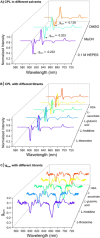Unusual Magnetic Field Responsive Circularly Polarized Luminescence Probes with Highly Emissive Chiral Europium(III) Complexes
- PMID: 32959961
- PMCID: PMC7821146
- DOI: 10.1002/anie.202012133
Unusual Magnetic Field Responsive Circularly Polarized Luminescence Probes with Highly Emissive Chiral Europium(III) Complexes
Abstract
Chirality is ubiquitous within biological systems where many of the roles and functions are still undetermined. Given this, there is a clear need to design and develop sensitive chiral optical probes that can function within a biological setting. Here we report the design and synthesis of magnetically responsive Circularly Polarized Luminescence (CPL) complexes displaying exceptional photophysical properties (quantum yield up to 31 % and |glum | up to 0.240) by introducing chiral substituents onto the macrocyclic scaffolds. Magnetic CPL responses are observed in these chiral EuIII complexes, promoting an exciting development to the field of magneto-optics. The |glum | of the 5 D0 → 7 F1 transition increases by 20 % from 0.222 (0 T) to 0.266 (1.4 T) displaying a linear relationship between the Δglum and the magnetic field strength. These EuIII complexes with magnetic CPL responses, provides potential development to be used in CPL imaging applications due to improved sensitivity and resolution.
Keywords: chirality; circularly polarized luminescence; lanthanide; magnetic properties.
© 2020 The Authors. Published by Wiley-VCH GmbH.
Conflict of interest statement
The authors declare no conflict of interest.
Figures





References
-
- Wong H.-Y., Lo W.-S., Yim K.-H., Law G.-L., Chem 2019, 5, 3058–3095.
-
- Zhao X., Zang S. Q., Chen X., Chem. Soc. Rev. 2020, 49, 2481–2503. - PubMed
-
- Rikken G. L. J. A., Raupach E., Nature 1997, 390, 493–494.
-
- Jin Q., Chen S., Sang Y., Guo H., Dong S., Han J., Chen W., Yang X., Li F., Duan P., Chem. Commun. 2019, 55, 6583–6586. - PubMed
-
- Jiang Q., Xu X., Yin P. A., Ma K., Zhen Y., Duan P., Peng Q., Chen W. Q., Ding B., J. Am. Chem. Soc. 2019, 141, 9490–9494. - PubMed
Publication types
LinkOut - more resources
Full Text Sources
Miscellaneous

